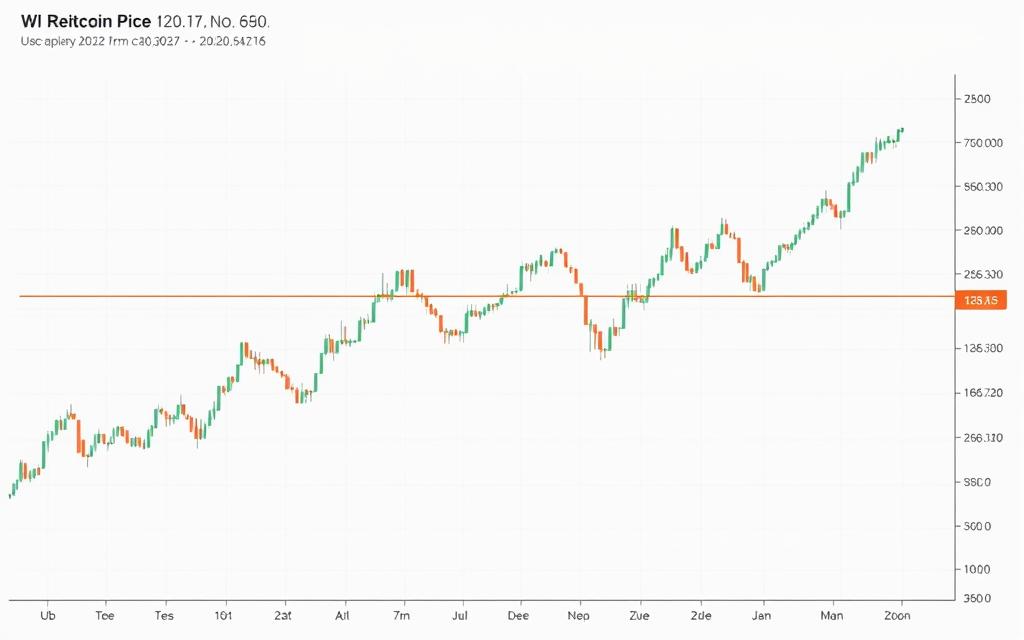Table of Contents
The cryptocurrency market has experienced a significant downturn, with Bitcoin’s price dropping below $108,000. Data from Cointelegraph Markets Pro and Bitstamp shows Bitcoin trading in a third straight bearish session, indicating increasing downward momentum.
Multiple factors have contributed to this decline, including resistance at key technical levels and changing Federal Reserve policy expectations. As the market continues to fluctuate, understanding the current price action requires examining various perspectives, including technical analysis and macroeconomic influences.
This article will provide a comprehensive analysis of the recent market trends and the factors driving the current trading environment, offering insights into the cryptocurrency’s valuation.
The Recent Bitcoin Price Decline
Bitcoin’s price has experienced a significant decline recently, sparking concern among investors. As of Monday, June 2, 2025, Bitcoin was trading at around $104,823, after retreating from recent highs near $112,000. This represents a substantial pullback from its all-time high just below $112,000.
Current Price Overview
The current Bitcoin price is $104,823, reflecting a decrease from its recent peak. The market is closely watching this trend, as it indicates a potential shift in investor sentiment. The trading volume has seen an increase, suggesting active participation from both buyers and sellers during this period of price discovery.
| Date | Bitcoin Price | Change |
|---|---|---|
| June 2, 2025 | $104,823 | -6.7% |
| Previous Peak | $112,000 | – |
Magnitude of the Drop
The magnitude of Bitcoin’s recent price decline represents a pullback of approximately 6-7% from its recent peak near $112,000. This correction has erased several weeks of gains for Bitcoin, though it remains significantly higher on a year-to-date basis compared to traditional financial assets. Historical patterns suggest that Bitcoin typically experiences several significant pullbacks during bull market cycles, with corrections of 20-30% not uncommon.
- The current price action places Bitcoin at a critical juncture, where technical analysts are evaluating whether this represents a healthy correction or the beginning of a more substantial downward move.
- Increased trading activity accompanies Bitcoin’s retreat from its all-time high, indicating active market participation.
Key Resistance Levels That Triggered the Decline
The recent decline in Bitcoin’s price can be attributed to the cryptocurrency hitting a major resistance level near $112,000. This significant price point has been a focal point for market participants, influencing trading decisions and overall market sentiment.
The $108,000-$112,000 Resistance Zone
The price range between $108,000 and $112,000 represents a crucial resistance zone for Bitcoin. As the cryptocurrency’s price approached this zone, it faced significant selling pressure, leading to a decline in its value. According to recent news, Bitcoin’s approach to this key resistance level has been a major factor in its current price action.
Historical Significance of These Price Points
The historical significance of the $108,000-$112,000 resistance zone cannot be overstated. Bitcoin’s all-time high just below $112,000 is a significant psychological and technical level. Technical analysts note that round numbers, particularly those near all-time highs, often serve as natural resistance points where market participants reassess valuations and engage in profit-taking behavior. Historical price data shows that Bitcoin typically experiences increased volatility and trading volume near such significant levels.
The current price structure is validating a bull flag pattern on daily charts, with support at $106,000, or the upper boundary of the flag. This support level is critical for bulls to defend to maintain the upward momentum. As market participants continue to monitor this support level, the market remains sensitive to any signs of weakness or strength in Bitcoin’s price action.
Federal Reserve Policy Impact on Bitcoin
The Federal Reserve’s monetary policy decisions have become a crucial factor influencing Bitcoin‘s price movements. As the central bank of the United States, the Federal Reserve’s actions on interest rates and monetary easing or tightening have far-reaching implications for financial markets, including the cryptocurrency market.
Fading Rate Cut Expectations
The recent shift in expectations regarding potential rate cuts by the Federal Reserve has had a significant impact on market sentiment. Initially, investors were anticipating a more dovish stance from the Fed, which would have likely supported risk assets like Bitcoin. However, as rate cut expectations faded, the trading environment became less favorable for cryptocurrencies.
This change in monetary policy outlook has led to increased volatility in the crypto market, with investors reassessing their positions based on the latest economic data and Fed announcements.

How Monetary Policy Affects Cryptocurrency Markets
Monetary policy decisions by central banks, particularly the Federal Reserve, have emerged as critical drivers of cryptocurrency price movements through their impact on global liquidity conditions. When central banks maintain loose monetary policy with low interest rates, risk assets including Bitcoin tend to benefit from increased liquidity flowing into financial markets seeking higher returns.
Conversely, tightening monetary conditions through higher interest rates or reduced asset purchases typically create headwinds for cryptocurrencies by making risk-free investments more attractive by comparison. The growing sensitivity of the cryptocurrency market to monetary policy highlights its evolution from a niche alternative asset to a more integrated component of the broader finance ecosystem influenced by macroeconomic conditions.
As a result, understanding the Federal Reserve’s policy decisions is crucial for trading and investing in crypto assets today, as it directly impacts the support and resistance levels in the channel of Bitcoin‘s price movements, making it essential to stay updated with the latest news.
Consumer Price Index Data and Its Influence
The latest CPI data has sent ripples through the financial markets, impacting Bitcoin’s price and market sentiment. As a result, the US Dollar Index (DXY) fell to a multi-month low of 98.5, wiping out the chances of the US Federal Reserve’s interest rate cut next week.
May CPI Figures Analysis
The May CPI figures revealed a complex inflation scenario, influencing market expectations and monetary policy outlook. Trading volumes increased significantly following the CPI release as market participants repositioned their portfolios based on the updated inflation outlook. The data highlighted the evolving narrative around Bitcoin’s relationship with inflation, suggesting that market participants are currently more focused on liquidity conditions than inflation hedging.
Market Reaction to Inflation Numbers
The financial markets displayed a complex reaction to the May inflation data. Despite reduced expectations for immediate Federal Reserve rate cuts, the DXY fell to a multi-month low. Market attention has quickly pivoted to the upcoming Producer Price Index (PPI) data scheduled for release on June 12, which could provide additional insights into inflation trends and potentially trigger further price volatility.
The cryptocurrency market’s reaction to inflation data demonstrates its increasing integration with traditional financial markets and sensitivity to macroeconomic indicators that influence monetary policy decisions. Investors are now closely watching the PPI data for further cues on inflation and potential market movements.
Technical Analysis of Bitcoin’s Current Position
Bitcoin’s current market position is under scrutiny as technical analysts examine the Bull Flag pattern and RSI indicators for signs of future price movements. Understanding these technical indicators is crucial for traders and investors looking to navigate the volatile cryptocurrency market.
Bull Flag Pattern Validation
The Bull Flag pattern is a technical chart pattern that indicates a potential continuation of an uptrend. For Bitcoin, the validation of this pattern involves analyzing the price action over a specific period. If the pattern holds, it could signal a further increase in Bitcoin’s price. However, if the pattern fails, it may indicate a reversal or a significant downturn.

RSI Indicators and Momentum Signals
The Relative Strength Index (RSI) is a momentum indicator that measures the speed and change of price movements. Currently, Bitcoin’s RSI has dropped from 64 to 56 over the last four days, indicating decreasing bullish momentum. Technical analysts note that while the RSI remains above the neutral 50 level, its downward trajectory suggests weakening buying pressure. Additional indicators like the Moving Average Convergence Divergence (MACD) and stochastic oscillators are also showing signs of waning bullish momentum, creating a confluence of technical signals that warrant caution from traders.
| Indicator | Current Value | Trend |
|---|---|---|
| RSI | 56 | Downward |
| MACD | – | Decreasing Bullish Momentum |
| Stochastic Oscillator | – | Decreasing Bullish Momentum |
For more detailed analysis and technical charts, traders can refer to resources like Investtech, which provide comprehensive market data and insights.
Critical Support Levels to Watch
Bitcoin’s recent decline has made it essential to examine the critical support levels that could influence its future price movements. The cryptocurrency market is highly volatile, and understanding these levels is crucial for traders and investors alike.

The $106,000 Support Level
The $106,000 support level is a crucial threshold for Bitcoin’s price today. If this level gives in, the next major defensive position for bulls would be the $100,000 mark. Technical analysis suggests that breaking below $106,000 could lead to a deeper correction toward the bear flag target of approximately $97,709.
Traders are closely monitoring this level as it represents a significant point of support. The trading activity around this level will be critical in determining Bitcoin’s short-term price direction.
Psychological Support at $100,000
The $100,000 level represents a critical psychological support for Bitcoin. Round number thresholds like $100,000 typically attract significant attention from traders and often serve as natural price magnets during volatile market conditions. Historical price action demonstrates that psychological levels like $100,000 often experience increased trading activity and can serve as reversal points.
Market sentiment indicators show that retail traders, in particular, tend to place significant emphasis on round number thresholds like $100,000, making these levels important from both technical and psychological perspectives.
| Support Level | Price | Significance |
|---|---|---|
| Current Support | $106,000 | Critical threshold for short-term price direction |
| Psychological Support | $100,000 | Significant attention from traders, potential reversal point |
| Yearly Opening | $92,000 | Potential worst-case scenario if current support levels fail |
Why Did Bitcoin Drop? Comprehensive Factors Analysis
Understanding the reasons behind Bitcoin’s recent price drop requires examining various market and economic indicators. The decline is not attributed to a single factor but rather a combination of macroeconomic pressures, technical selling triggers, and profit-taking behavior among investors.
Macroeconomic Pressures
Macroeconomic pressures have played a significant role in Bitcoin’s recent price decline. The Federal Reserve’s monetary policy decisions, particularly regarding interest rates, have influenced investor sentiment. Fading expectations of rate cuts have led to a decrease in investment in risky assets like Bitcoin. Additionally, the Consumer Price Index (CPI) data released recently showed inflation numbers that were higher than expected, further impacting market sentiment.
| Macroeconomic Factor | Impact on Bitcoin |
|---|---|
| Federal Reserve Policy | Influenced investor sentiment and reduced investment in risky assets |
| CPI Data | Higher-than-expected inflation numbers negatively impacted market sentiment |
Technical Selling Triggers
Technical analysis reveals that selling triggers were activated as Bitcoin approached key resistance levels. The $108,000-$112,000 resistance zone proved to be a significant overhead resistance, triggering selling activity. Technical indicators such as the Relative Strength Index (RSI) also signaled overbought conditions, prompting some investors to sell.

Profit-Taking Behavior
Profit-taking behavior has emerged as a significant factor in Bitcoin’s price decline. Following May’s 11% rally, many investors chose to secure gains, leading to increased selling pressure. On-chain data indicates a rise in Bitcoin movement from long-term holding addresses to exchanges, suggesting even committed investors were taking profits near all-time highs. The concentration of profit-taking near the $110,000-$112,000 resistance zone aligns with technical analysis, indicating significant overhead resistance.
- Profit-taking behavior intensified after May’s rally, contributing to the price decline.
- On-chain data shows increased Bitcoin movement to exchanges, indicating profit-taking.
- The $110,000-$112,000 zone was a key area for profit-taking activity.
Market Sentiment Indicators
The recent Bitcoin price decline has led to a shift in market sentiment, with various indicators showing mixed signals. Understanding these indicators is crucial for investors looking to navigate the current market.
Institutional Investor Positioning
Institutional investors have been closely watching the market, adjusting their positions in response to changing market conditions. According to recent data, institutional investors have been reducing their exposure to Bitcoin, likely due to the declining price and increased volatility. As market sentiment continues to shift, institutional investors are adopting a cautious approach, waiting for clearer directional signals before re-entering the market.

Retail Trader Sentiment
Retail trader sentiment indicators present a mixed picture. Social media metrics show declining bullish enthusiasm compared to peak levels when Bitcoin was approaching its all-time high. Exchange data reveals that smaller wallet addresses, typically associated with retail traders, have shown increased selling activity during recent price declines. The Fear and Greed Index readings have declined from “Extreme Greed” territory to more neutral levels, indicating a cooling of retail enthusiasm.
Some key observations include:
- Declining conversation volume and sentiment on social media platforms, suggesting waning retail interest.
- Survey data indicating that many smaller investors are adopting a wait-and-see approach, preferring to await clearer directional signals before committing additional capital to Bitcoin positions.
- Increased selling activity among retail traders during recent price declines.
As the market continues to evolve, understanding these sentiment indicators will be crucial for making informed trading decisions. The current market conditions highlight the importance of staying informed and adapting to changing sentiment.
Expert Opinions on the Recent Decline
Market analysts are closely watching Bitcoin’s price action, with several experts offering their insights into the recent decline and its implications for the cryptocurrency market. The consensus among experts is that the $106,000 support level is crucial for Bitcoin’s near-term price direction.
Michael van de Poppe’s Analysis
Michael van de Poppe, a renowned cryptocurrency analyst, has shared his analysis on Bitcoin’s recent price movement. According to van de Poppe, the key support level at $106,000 is critical for Bitcoin to maintain its upward trajectory. He notes that if this level gives in, the next significant support is at $100,000, a psychological level that could potentially see significant buying activity.
Van de Poppe also highlights the importance of the current trading channel and how it affects Bitcoin’s price. He suggests that as long as Bitcoin remains within this channel, the potential for a rebound remains high. However, a break below the channel could signal a deeper correction.

Other Market Analysts’ Perspectives
Other market analysts have also weighed in on Bitcoin’s recent decline, offering diverse perspectives on the potential causes and consequences. Some analysts point to the macroeconomic pressures and the impact of Federal Reserve policy on the cryptocurrency market.
A table summarizing the views of various analysts is provided below:
| Analyst | View on Bitcoin’s Price | Key Level |
|---|---|---|
| Michael van de Poppe | Bullish if $106,000 holds | $106,000 |
| Quantitative Analysts | Correction within normal parameters | $100,000 |
| Contrarian Analysts | Potential for reversal | $100,000 |
The varied opinions among analysts highlight the complexity of predicting Bitcoin’s price movements. As the market continues to evolve, staying informed with the latest analysis from experts will be crucial for investors.
Bitcoin’s Correlation with Traditional Markets
Bitcoin’s price movements have increasingly been correlated with traditional markets, including stocks and the US dollar. This relationship is crucial for investors to understand as it affects Bitcoin’s price dynamics.
Relationship with Stock Market Movements
The correlation between Bitcoin and the stock market has been a subject of interest among investors. Recent data shows that Bitcoin’s price movements have mirrored those of the stock market to some extent. When stock prices rise, Bitcoin tends to follow, and vice versa.
This correlation can be attributed to the growing involvement of institutional investors in the cryptocurrency market. As a result, Bitcoin’s price is now more closely tied to overall market sentiment.
| Market Condition | Bitcoin Price Movement | Stock Market Movement |
|---|---|---|
| Bullish | Increase | Increase |
| Bearish | Decrease | Decrease |
Dollar Strength Impact on Bitcoin
The strength of the US Dollar, as measured by the Dollar Index (DXY), has historically shown an inverse relationship with Bitcoin prices. When the dollar strengthens, Bitcoin tends to weaken.

Recent market data indicates that despite the Dollar Index falling to a multi-month low of 98.5 following the CPI data release, Bitcoin prices failed to gain sustained support due to other overriding factors.
Economic policies influencing dollar strength, such as interest rate differentials and trade policies, have become crucial for Bitcoin investors to monitor.
Geopolitical Factors Affecting Bitcoin Price
Global economic and political uncertainties have created a challenging environment for Bitcoin’s price stability. The cryptocurrency market is increasingly sensitive to geopolitical developments, which can significantly impact its volatility.
US-China Trade Tensions
The ongoing trade tensions between the US and China have been a significant geopolitical factor affecting Bitcoin’s price. These tensions contribute to global economic uncertainty, often leading to a flight to safety. However, assets like Bitcoin, perceived as risky, can suffer as investors favor traditional safe-havens.
Impact on Market Sentiment: The escalation of trade tensions can lead to decreased investor confidence, affecting Bitcoin’s price. The uncertainty surrounding trade policies can also influence the broader cryptocurrency market.
Global Economic Uncertainty
Global economic uncertainty has intensified, with indicators showing contraction in manufacturing activity across several major economies. This slowdown raises concerns about broader economic health, prompting investors to reevaluate their exposure to volatile assets like cryptocurrencies.
| Economic Indicator | Current Status | Impact on Bitcoin |
|---|---|---|
| Manufacturing Activity | Contracting | Negative |
| Inflationary Pressures | Elevated | Uncertain |
| Global Trade | Uncertain | Negative |
The strengthening of the US dollar as a safe-haven asset during times of economic uncertainty creates headwinds for dollar-denominated assets like Bitcoin, contributing to its recent price weakness.

Short-Term Price Predictions from Analysts
With the recent decline in Bitcoin’s price, experts are offering their predictions for the cryptocurrency’s short-term future. Analysts are closely monitoring various factors, including technical indicators and fundamental analysis, to forecast potential price movements.
Technical-Based Forecasts
Technical analysis suggests that Bitcoin’s price may continue to fluctuate within certain support and resistance levels. Some analysts predict that if Bitcoin can maintain its current support level, it may experience a rebound. Key technical indicators to watch include the Relative Strength Index (RSI) and moving averages.

Fundamental Analysis Projections
Fundamental analysis projections from major financial institutions remain broadly bullish on Bitcoin’s medium to long-term prospects. According to recent forecasts:
- Standard Chartered predicts $120,000 by Q2 2025 and $200,000 by the end of 2025.
- VanEck’s digital asset strategist projects a potential peak around $180,000 in 2025.
- ARK Invest maintains ambitious long-term price targets, ranging from $500,000 in their bear case to $2.4 million in their bull case by 2030.
These projections are based on factors such as adoption metrics, supply dynamics, and Bitcoin’s potential to capture portions of various global monetary functions.
AI Models and Their Bitcoin Price Forecasts
The integration of artificial intelligence (AI) in cryptocurrency market analysis has led to the development of sophisticated models that forecast Bitcoin’s price movements. These models are being increasingly used by traders and investors to gain insights into market trends and make informed decisions.
ChatGPT and xAI Grok Predictions
High-profile AI models, such as ChatGPT and xAI Grok, are providing unique perspectives on Bitcoin’s price trajectory. According to various forecasts, Bitcoin’s price is expected to fluctuate between $115,000 and $137,000 by early July. For instance, Changelly’s forecast predicts a peak at $137,189 by June 7, with support at $104,329.
Other AI-Based Market Analysis
Beyond the high-profile AI models, numerous specialized artificial intelligence systems are focused on cryptocurrency markets, providing additional analytical perspectives. Some key insights from these models include:
- Quantitative AI models employed by trading firms project potential price targets ranging from $115,000 to $137,000 for Bitcoin by early July.
- Sentiment analysis AI tools indicate a gradual shift from extreme optimism to more balanced sentiment, which historically has often preceded market recoveries.
- AI-powered on-chain analysis platforms suggest continued accumulation by long-term holders despite the price correction, interpreting this as a potentially bullish divergence.
The integration of AI forecasting tools into mainstream cryptocurrency analysis represents a significant evolution in market intelligence. While these models should be considered complementary to traditional analysis rather than definitive predictions, they offer valuable insights into market trends and potential future movements.
Trading Strategies During Bitcoin Volatility
Navigating Bitcoin’s volatile market requires strategic trading approaches. The cryptocurrency’s price fluctuations have significant implications for traders, making it essential to identify effective strategies for managing risk and capitalizing on opportunities.
Risk Management Approaches
Effective risk management is crucial when trading Bitcoin. Strategic traders are focusing on key price levels to determine potential entry and exit points. The resistance zone between $108,000 and $112,000 is a significant area where selling pressure has emerged repeatedly. To manage risk, traders are setting stop-loss orders below critical support levels, such as the $103,000-$105,000 range.
Key Risk Management Strategies:
- Setting stop-loss orders below support levels
- Identifying key resistance zones for potential exits
- Scaling into positions during deeper corrections
Key Levels for Position Entry and Exit
Technical analysis identifies several key levels for position entry and exit. The support cluster between $103,000 and $105,000 offers a potential entry zone for bullish traders. Additionally, the 200-day moving average around $97,600 is a major long-term support level that could attract significant buying interest if tested.
| Price Level | Action | Rationale |
|---|---|---|
| $108,000-$112,000 | Partial Profit-Taking | Recent resistance zone |
| $103,000-$105,000 | Potential Entry | Support cluster |
| $97,600 | Scaling into Positions | 200-day moving average |
By understanding these key levels and implementing effective risk management strategies, traders can better navigate Bitcoin’s volatile market. Risk-reward calculations suggest that entries near current support levels with targets at the recent resistance zone offer favorable ratios of approximately 3:1.
Conclusion: Bitcoin’s Outlook Amid Current Market Conditions
Despite the recent correction, Bitcoin’s long-term prospects remain strong, driven by institutional adoption and its growing role in the financial ecosystem. The cryptocurrency’s ability to maintain critical support levels around $105,000-$106,000 will be crucial in determining its near-term direction.
The current market sentiment has shifted from extreme optimism to a more balanced perspective, potentially creating healthier conditions for sustainable growth once the correction completes. Technical analysis indicates that Bitcoin remains in a broader uptrend on higher timeframes, suggesting that the recent pullback may be a normal bull market correction rather than a reversal of the primary trend.
Macroeconomic factors, particularly Federal Reserve policy decisions and inflation trends, will continue to influence Bitcoin’s price action. The increasing correlation between the cryptocurrency market and traditional financial markets means that broader risk sentiment will remain an important driver of Bitcoin’s performance.
Trading strategies during this period of uncertainty should emphasize risk management and patience. Strategic positioning near key support levels could offer favorable risk-reward opportunities for traders with appropriate time horizons and risk tolerance.
Artificial intelligence models and expert analyst projections maintain generally optimistic medium-term outlooks, with consensus forming around potential price targets in the $115,000-$130,000 range by the end of June if key support levels hold. Institutional positioning data indicates continued accumulation despite the price correction, suggesting that professional investors view current price levels as attractive for building or maintaining Bitcoin exposure.
As the market navigates this period of price discovery and volatility, maintaining perspective on Bitcoin’s historical pattern of significant corrections within broader bull markets provides important context for interpreting current price action and developing appropriate investment strategies.
FAQ
What triggered the recent decline in Bitcoin’s price?
The decline was triggered by a combination of factors, including macroeconomic pressures, technical selling triggers, and profit-taking behavior, as well as concerns over Federal Reserve policy and Consumer Price Index data.
How does the Federal Reserve’s monetary policy impact Bitcoin’s price?
The Federal Reserve’s monetary policy decisions, such as rate cuts or hikes, can significantly affect Bitcoin’s price by influencing investor sentiment and the overall direction of the financial markets.
What is the significance of the 8,000-2,000 resistance zone for Bitcoin?
The 8,000-2,000 resistance zone has historically been a significant level for Bitcoin, and the failure to break through this zone led to a decline in price as investors took profits and reduced their exposure.
What are the key support levels to watch for Bitcoin?
The key support levels for Bitcoin are 6,000 and 0,000, which are critical psychological and technical levels that could determine the cryptocurrency’s short-term price direction.
How do market sentiment indicators influence Bitcoin’s price?
Market sentiment indicators, such as institutional investor positioning and retail trader sentiment, play a crucial role in determining Bitcoin’s price movements, as they reflect the overall attitude of investors towards the cryptocurrency.
What are the short-term price predictions for Bitcoin from analysts?
Analysts’ short-term price predictions for Bitcoin vary, with some predicting a rebound based on technical analysis, while others expect continued volatility due to macroeconomic and geopolitical factors.
How does Bitcoin’s correlation with traditional markets affect its price?
Bitcoin’s correlation with traditional markets, such as the stock market, can impact its price, as investors often view the cryptocurrency as a risk-on or risk-off asset, leading to price movements in tandem with other assets.
What role do AI models play in predicting Bitcoin’s price?
AI models, such as ChatGPT and xAI Grok, are being used to predict Bitcoin’s price by analyzing large datasets and identifying patterns, providing valuable insights for investors and traders.









